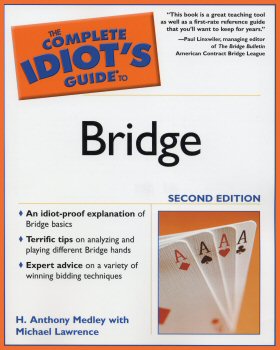| The first edition of Complete Idiot's Guide to Bridge by H. Anthony Medley was the fastest selling beginning bridge book, going through more than 10 printings. This updated Second Edition includes some modern advanced bidding systems and conventions, like Two over One, a system used by many modern tournament players, Roman Key Card Blackwood, New Minor Forcing, Reverse Drury, Forcing No Trump, and others. Also included is a detailed Guide to Bids and Responses, along with the most detailed, 12-page Glossary ever published, as well as examples to make learning the game even easier. Click book to order. | ||
|
|
||
|
Bright Star (5/10) by Tony Medley Run time 119 minutes. OK for children. This epitomizes the danger of a writer directing
her own screenplay. Jane Campion fell in love with her words and scenes
and couldn’t bring herself to bring this in at 90 minutes, which is all
the story deserves. As a result, this stumbles along for so long that
one loses the context. The story of the love between doomed 23-year-old
romantic poet John Keats (Ben Whishaw) and his next-door neighbor
18-year-old Fanny Brawne (Abbie Cornish) circa 1818-20, Campion tells us
very little about either, except that they fall in love. It is almost
unbelievable that you can sit through this film for a minute under two
hours and come away not knowing what it was that Keats was working so
feverishly on with his friend, Mr. Brown (Paul Schneider, in a terrific
performance; it could be “Otho the Great,” for which Brown claims he
gave “the fable, characters,
and dramatic conduct of a tragedy, and [Keats] was to embody it into
poetry”), why Brown has such an intense dislike of Fanny, what
happened to Fanny’s father, or what it is that supports Fanny’s family.
Campion keeps everything a secret. The family is shown as Fanny,
her brother and sister, Samuel (Thomas Brodie Sangster) and Margaret
(Edie Martin), and her mother, Mrs. Brawne (Kerry Fox, in an
award-deserving performance). Where’s Mr. Brawne? In two hours, Campion
gives us not a clue about any of these people. Oh, that is, except that
Fanny and Keats are in love. There’s really no explanation for that
either, because they are rarely together alone. But, boy, does she love to have her actors spout
poetry. Campion admits she worked hard to have as much poetry in the
film as possible, but Keats wrote these things as either individual
poems or as letters to Fanny. They weren’t verbalized; they were written
poems. They lose their impact when they are translated into dialogue.
Campion would have been better advised to cut some of the poetry, which
some might love, but most will find too much, and let the audience in on
some facts on why they lived the way they did and what made each of them
tick. But, to be fair to Campion, while she says she
tried to be true to the facts, she had to recreate a lot of this. While
Fanny kept all of Keats’ letters, Keats destroyed all of Fanny’s so
Campion was left to recreate Fanny out of what Keats wrote to her, a
difficult task. And Brown, in his biography of Keats, never mentions
Fanny. The film is gorgeously photographed by DOP Greig
Fraser. In addition to the exceptional lighting of many of the scenes,
he also participated in choosing the locations, which emphasized the
romanticism of the film. In fact, for me, other than looking at the
deliciously beautiful Cornish, of whom I’ve been an admirer since the
salacious “Somersault” (2004), the best part of the film is the
photography and scenes, some of which looked to me like impressionist
paintings. Production designer Janet Patterson deserves kudos for the
attention to detail in recreating the Regency period, which reflects how
bare things were. Spoiler alert. Campion also fails to accurately
disclose what happened to Fanny, actually misleading the audience to
believe that she spent the rest of her life in mourning, wandering
through the forest thinking of Keats. In fact, she married in 1833, 12
years after Keats’ death, and had two children, although she apparently
never took off the ring Keats gave her. I hesitate to call this a chick flick, but it is
most likely to appeal to highly romantic females. Men are likely to
squirm. If it came in at ninety minutes, though, this would be a lot
more compelling, even for men.
|
||
